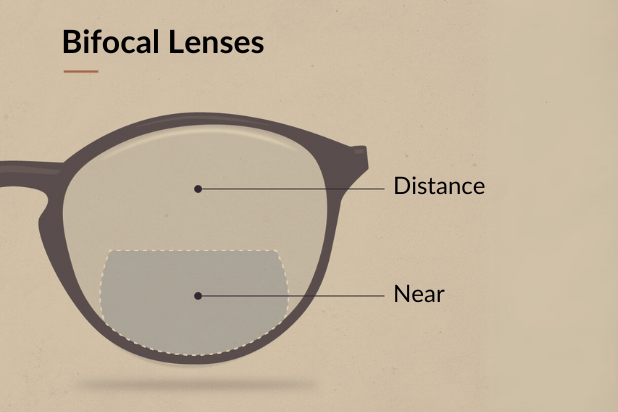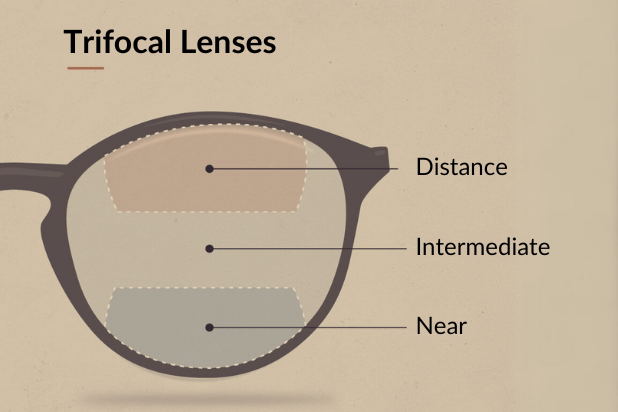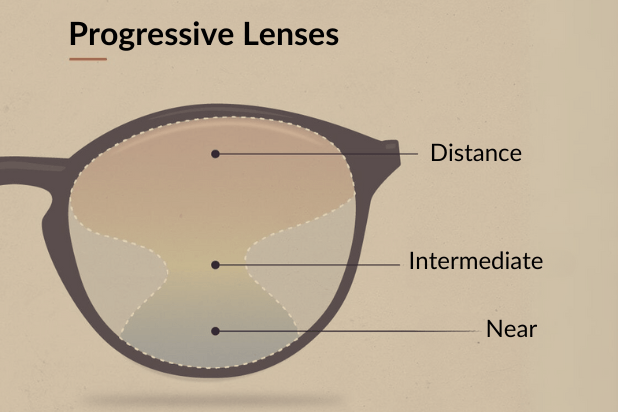Difference Between Bifocal, Trifocal, and Progressive Lenses
There are many different types of correction your eyes might need, so there are several choices regarding what type of lens you may have in your prescription glasses. Bifocals, trifocals, and progressive lenses offer different types of vision correction, and one may be best for you, depending on your visual demands. While children can be prescribed a bifocal lens for a lazy eye or an eye turn (strabismus), the lens is typically prescribed for a patient after the age of 40. Presbyopia is when the eye can no longer focus on things up close, and a lens with a reading component is prescribed. If your prescription has the word “add” and a plus sign with a number, you require a lens with a reading addition and should order a bifocal, trifocal or progressive lens.This article will explore the difference between these lens types and how to decide which is right for your needs.
How Bifocals Work

Bifocal lenses are a type of lens for prescription eyeglasses that offer two strengths of correction combined in a single lens. Generally, the top portion of the lens provides correction for distance vision, and the bottom portion helps you with near vision. The near portion is often called a segment or an add. The add will range in power from +1.00 to +3.00 diopters.
Bifocal lenses work the same way as other prescription lenses. Prescription lenses use the right amount of curvature to focus light rays on the retina. The curvature of a prescription lens is created to counteract problems with the shape or curvature of your cornea that distort your vision in the first place. Lenses get thicker or thinner at the center or the edges depending on whether you need help seeing objects that are close or far. Concave lenses are used to help improve distance vision, and convex lenses are used to help improve close vision. Convex lenses are thicker at the center and thinner at the edges and curve outward. A convex lens magnifies objects and is used for the bifocal.
Once the lens refocuses the beams of light coming into your eye, receptors in your retina are able to process a clearer image.
Bifocals combine two different types of curvature and lens power. Traditionally, these two levels of correction would have required two different pairs of glasses. The two different strengths are usually separated by a visible line. Common styles for bifocals use the main area of the lens to correct distance vision, with a smaller segment with more magnification for seeing up close. You look through the bottom segment specifically when you are reading or looking at close objects.
The magnification segment can be ordered in different shapes, including:
- A half-moon or D shape at the base of the lens
- A round shape at the base of the lens
- A narrow rectangle at the base of the lens
- An equal amount of distance lens and near the lens correction separated in the center of the frame is called an executive.
A half-moon or D shape, also called a flat-top, is the most common type of bifocal.
Pros of Bifocal Lenses
Bifocals are beneficial, especially if you require more than one type of vision correction.
- Bifocal lenses are convenient for people who need both their near and far vision corrected.
- Bifocals combine two pairs of eyeglasses into one.
- Bifocals have two types of vision correction in a single lens.
- Combining two lens powers into a single pair of eyeglasses can save you money.
Cons of Bifocal Lenses
Bifocals aren’t for everyone, though. There are some disadvantages to these types of lenses.
- You will be able to see a visible line between the two different areas of vision correction.
- It can take some time to get used to looking through two different areas for your near and far vision correction.
- Your initial pair of eyeglasses with bifocal lenses may cost more than a pair of eyeglasses with single vision correction.
- Your field of view for reading is limited by the window size.
- Bifocals do not have an intermediate zone for computer work.
- You experience an image jump when focusing from distance to near view.
How Trifocals Work

Trifocals are similar to bifocals but offer three levels of vision correction. These lenses offer near and far vision correction like bifocals but add an intermediate level of correction for objects that are about an arm’s length away. Trifocals help you to view the dashboard on your car, your cup at the dinner table, and your desktop computer.
Pros of Trifocal Lenses
Trifocals offer several advantages to people with complex vision needs.
- Trifocals are essentially a three-in-one product.
- They can help you see at multiple distances without requiring you to buy and carry around three different pairs of glasses.
- A trifocal lens offers convenience and cost savings if you require three distances of vision correction.
Cons of Trifocal Lenses
Trifocals are useful for their purpose, but there are some disadvantages.
- The different sections of the lens are usually separated by visible lines that some people may find cosmetically unappealing.
- Trifocals can be more expensive than single-vision lenses.
- Your initial pair of eyeglasses with bifocal lenses may cost more than a pair of eyeglasses with single vision correction.
- It can take some time to get used to looking through the three different areas of the lens.
- Each window offers a small area of viewing.
- You experience an image jump when focusing from distance to near.
How Progressives Work

Progressives offer many powers of vision correction in a single lens. The one-piece lens increases in magnification gradually from top to bottom instead of separating the powers with lines. This provides a range of corrections in a single lens without visible separation. A progressive lens is often called a PAL by your doctor, which stands for progressive addition lens. Multifocal or no-line bifocal are also commonly used but keep in mind that a no-line bifocal will only correct for distance and the near visual fields without an itemediate.
Pros of Progressive Lenses
Progressive lenses give you multi-power vision correction in a single lens, but there are other benefits, too.
- Progressives offer the most comprehensive vision correction because multiple levels of correction are combined into a single lens.
- Progressive lenses offer the most natural view with a gradual change in prescription power.
- These lenses are often preferred by people with complex prescription or advanced visual needs who don’t want to carry around multiple pairs of glasses.
- The added benefit of a progressive lens over a bifocal or trifocal is that there are no visible lines between the different areas of correction, and a progressive lens looks just like a single-vision lens.
Cons of Progressive Lenses
Though there are many benefits, progressive lenses have some disadvantages.
- Progressive lenses can be costly—more so than bifocals or trifocals.
- Without the visual clue of lines within the lens to guide you, you could find yourself scanning through different areas of the lens to find the help you need.
- It can take time to get used to the different areas of correction on the lens. This can be disorienting or annoying for some people or even cause eye strain.
- Depending on the selected design,they can be difficult to use on the computer, depending upon the setup of your computer or workstation.
- You have to point your nose towards what you view and not just your eyes. If you move just your eyes, you will run into a blur on the sides of the lens which is also called the swim effect.
Which Option Is Right for You?
Choosing between bifocals, trifocals, and progressive lenses is a matter of your prescription, visual needs, personal preferences, and budget. Bifocals are an easy choice if you only need two levels of correction, but if you need intermediate vision correction, such as a desktop computer, you should consider a trifocal. Choosing between bifocals or trifocals and progressives is a bit more complicated. Many people who choose progressives prefer a lens without the visible line over the line in bifocals and trifocals. These lenses will cost more and may be difficult to adapt to during the first several weeks. Doctors recommend wearing your progressives full-time for the first two weeks for the best adaptation. You must train your brain and eyes on how to use the lenses.
Your eye doctor and eyeglass retailer can help guide you on the best choice for your vision needs and lifestyle. Overnight Glasses has progressive lenses in multiple styles and packages, as well as multiple bifocal options. Customer service representatives can help guide your choice and get you a new pair of glasses quickly and for an affordable price.
Conclusion
There are many options when it comes to lenses for your prescription eyeglasses. Your individual prescription and vision demands will dictate the type of lens you need, but there are also style choices you can make based on your lifestyle, personal preferences, and budget. Bifocals, trifocals, and progressive lenses all offer multiple types of vision correction in a single pair of glasses. The biggest difference between these types is how the different areas of correction are demarcated and whether they are separated by visible lines. If you use a desktop computer for either a hobby or occupation, a trifocal or an office progressive lens will function best. Visit OvernightGlasses.com to view our selection of bifocals, no-line bifocals, and progressives.
